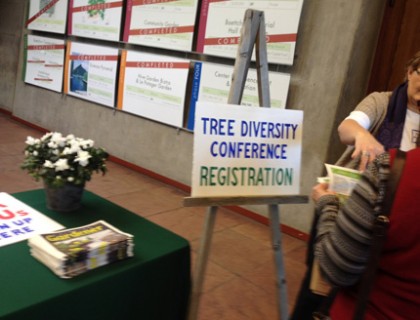This past Spring, tree enthusiasts from around the region gathered at the Denver Botanic Gardens to listen and learn from various presenters on the theme of Tree Diversity for Colorado. It seems recent crises such as the discovery of Emerald Ash Borer infestation in Boulder has revealed the urgency for members of the Green Industry to seek out more hardy and appropriate tree species for our region. There are other reasons to seek out trees better adapted to our climate. As climate scientists continue to inform us, it is likely that Colorado’s climate will get warmer and drier, providing even more challenging growing conditions for trees. Also, biotic mixing will continue to increase as more people move goods and materials far and wide across the globe. That is the most probable scenario of how EAB was found in Boulder: it was brought there in a wooden crate shipped from Asia. What far-flung exotic pest will next appear in our area?
This year’s conference was the second occurrence of such a gathering in Denver. Several new tree species were presented to the audience, along with some old stand-bys, with a discussion of each tree’s merits.
Although there were several genera that are represented in the group of trees, the two genera with the most candidates are Maples and Oaks. The other genus with multiple species that should get wider consideration for planting in our area is Ulmus (elms). While most elms have been looked over because of Dutch Elm Disease and also the invasive nature of Siberian Elm (Ulmus pulmila), there are a few cultivars that we should consider planting in Denver.
Here are ten trees that were discussed at the conference (out of many others) that you might consider planting in Colorado and the surrounding region:
Acer grandidentatum ‘Manzano’ – Manzano Bigtooth Maple Ht: 20-30’ Wd: 20-30’
Large shrub or small tree with rounded form. The Manzano is a more tree like form of bigtooth maple. Once established, the bigtooth maples are drought tolerant.
Acer miyabei ‘Morton’ – State Street Maple Ht: 50’ Wd: 35’
Rough corky bark and leaf shape are similar to Hedge Maple, but its stronger growth rate and ascending branch habit result in a larger mature size. Excellent drought and cold tolerance. Very adaptable.
Acer saccharum ‘Collins Caddo’ – Collins Caddo Sugar Maple Ht: 45’ Wd: 40’
This maple provides red fall color, but unlike a red maple like Autumn Blaze (Acer x freemanii), the sugar maples are more adapted to the alkaline soils of Colorado’s Front Range urban corridor.
Acer tataricum ‘JFS-KW2’ – Rugged Charm Maple Ht: 28’ Wd: 15’
Compact oval form. More upright than the popular Hot Wings Tatarian maple.
Quercus macrocarpa ’Bullet Proof’ – Bullet Proof Bur Oak Ht: 50-80’ Wd: 50-80’
This large oak sports a massive trunk, deeply furrowed, that supports corky ridged twigs on spreading branches that makes for a broad and rounded canopy. This variety is more resistant to the galls that can affect other Bur Oaks.
Quercus muehlenbergii – Chinkapin Oak Ht: 40’ Wd: 40’
A durable and adaptable oak with narrow lustrous glossy dark green leaves and an open, irregular, rounded habit. Prefers well drained soil.
Quercus robur x alba ‘JFS-KW1QX’ – Streetspire Oak Ht: 45’ Wd: 14’
Dark green leaves of this narrowly columnar tree are mildew resistant. Turning red in autumn, they fall to reveal stiffly upright branches. Similar to Crimson Spire, but does not hold brown foliage through the winter
Ulmus davidiana – David Elm Ht: 40’ Wd: 30’
Medium sized tree, with vase shape. Resistant to Dutch elm disease.
Ulmus propinqua ‘JFS-Bieberich’ – Emerald Sunshine Elm Ht: 35’ Wd: 25’
Grown from seed collected in China, this sturdy, upright-growing elm was selected for superior performance on the hot, arid, windswept plains of western Oklahoma. Handsome, deeply corrugated leaves emerge coppery-bronze and mature to glossy green.
Ulmus japonica x wilsoniana ‘Morton’ – Accolade Elm Ht: 70’ Wd: 60’
Arching limbs and a graceful vase shape (similar to the American elm) characterize this hybrid elm selected and tested at Morton Arboretum. Glossy, dark green foliage changes to yellow in the fall and is resistant to elm leaf beetle feeding.
This is the official blog of Outdoor Design Group, Colorado Landscape Architects. For more information about our business and our services, click here.
